Chronic Health Case Study: Heart Failure Management of Clare Giardini
VerifiedAdded on 2023/01/11
|9
|2827
|42
Case Study
AI Summary
This case study focuses on Clare Giardini, a 70-year-old woman with a complex medical history including osteoarthritis, non-insulin dependent diabetes, hypertension, systolic dysfunction, and chronic controlled atrial fibrillation, who frequently presents to the hospital with shortness of breath. The report analyzes relevant data for a comprehensive nursing assessment, including her medications (Metformin, Paracetamol, Diclofenac, Quinapril, Furosemide), vital signs, and social history. It identifies contributing factors to her chronic conditions and current health exacerbation, such as medication interactions and lifestyle. The case study emphasizes nursing assessments, interventions, and strategies for effective self-management, including education on nutrition, exercise, and medication adherence. The role of nurses in chronic disease self-management, including patient education and pharmacological assessment, is discussed, alongside primary and secondary health promotion strategies. The study highlights the importance of a multidisciplinary approach and evidence-based interventions to improve Clare's health outcomes, considering her family history and social support.
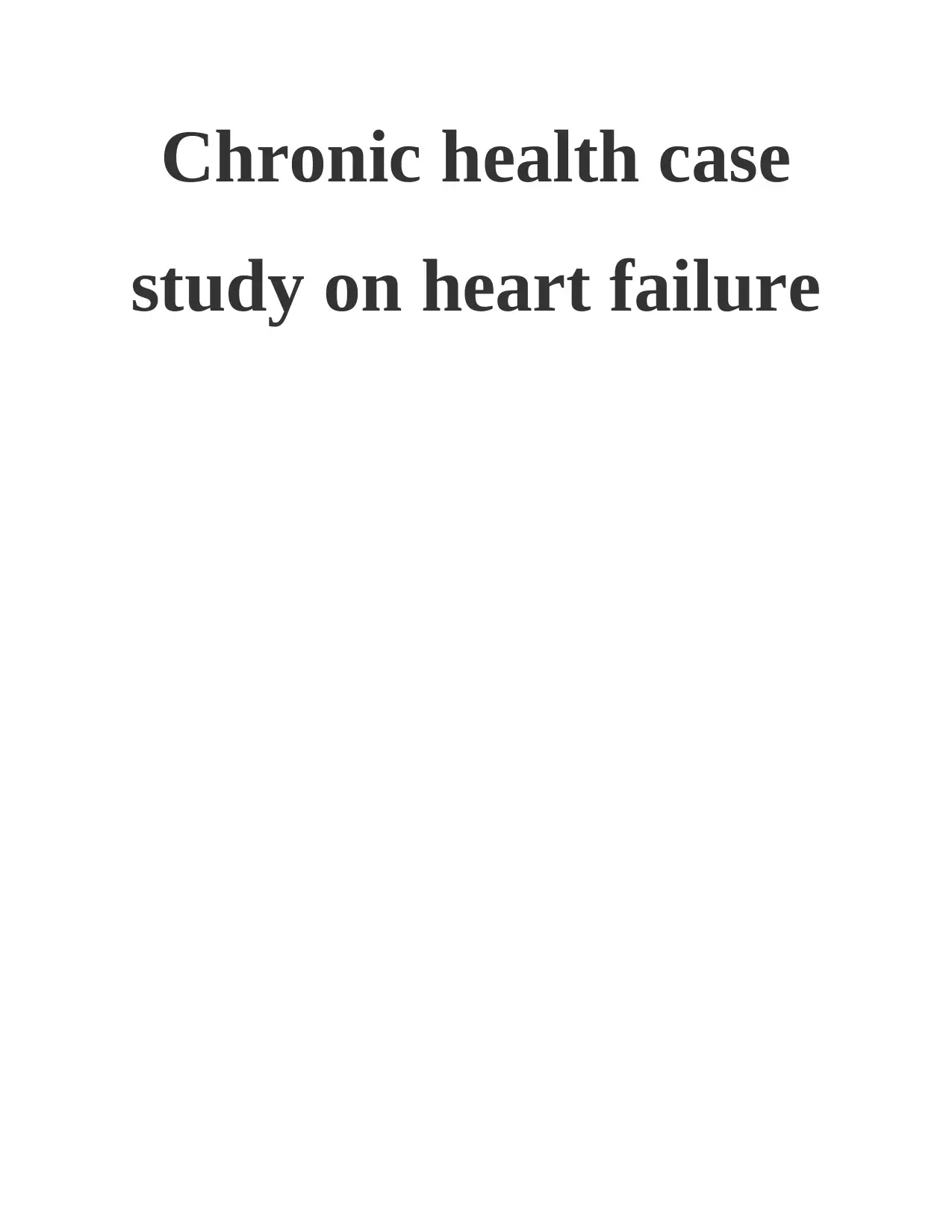
Chronic health case
study on heart failure
study on heart failure
Paraphrase This Document
Need a fresh take? Get an instant paraphrase of this document with our AI Paraphraser
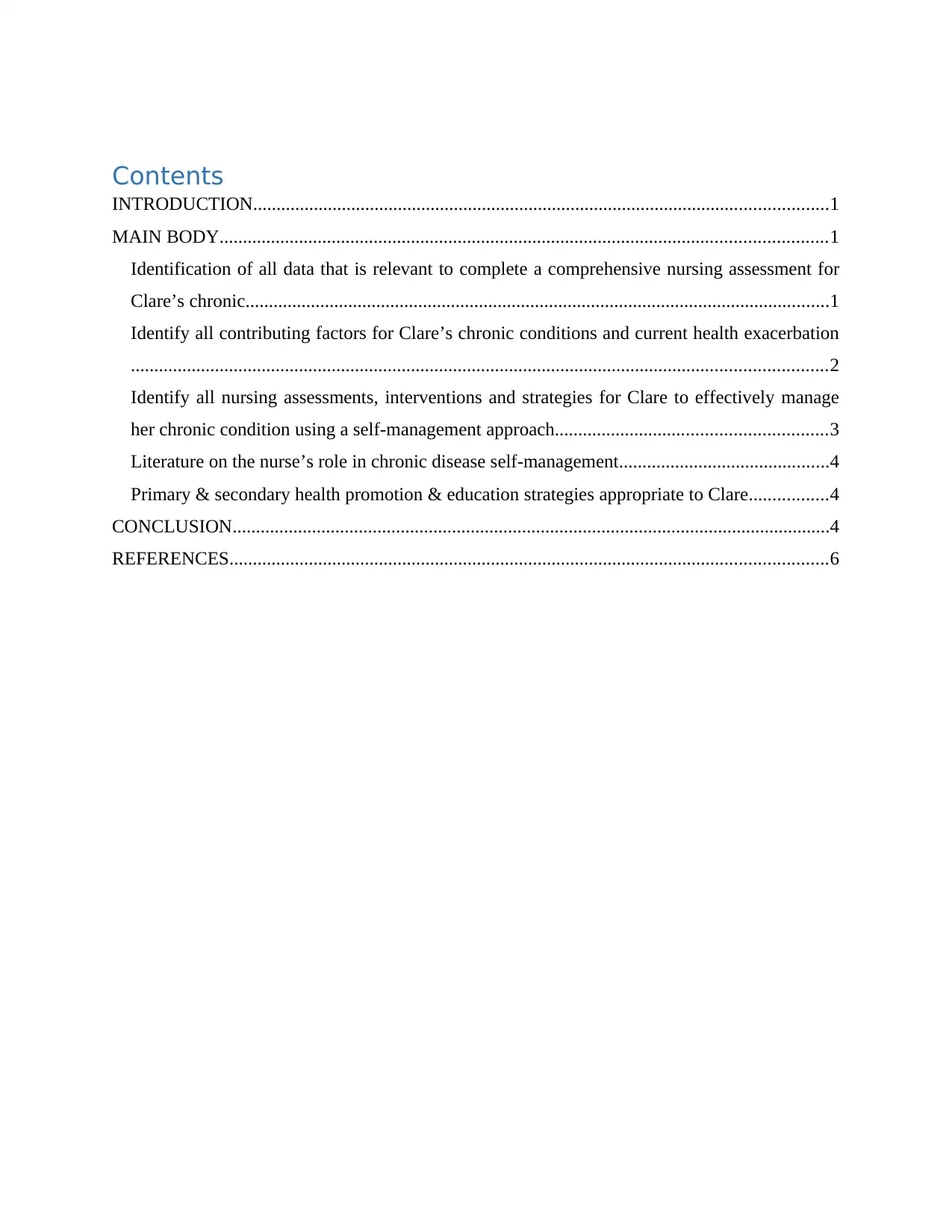
Contents
INTRODUCTION...........................................................................................................................1
MAIN BODY..................................................................................................................................1
Identification of all data that is relevant to complete a comprehensive nursing assessment for
Clare’s chronic.............................................................................................................................1
Identify all contributing factors for Clare’s chronic conditions and current health exacerbation
.....................................................................................................................................................2
Identify all nursing assessments, interventions and strategies for Clare to effectively manage
her chronic condition using a self-management approach..........................................................3
Literature on the nurse’s role in chronic disease self-management.............................................4
Primary & secondary health promotion & education strategies appropriate to Clare.................4
CONCLUSION................................................................................................................................4
REFERENCES................................................................................................................................6
INTRODUCTION...........................................................................................................................1
MAIN BODY..................................................................................................................................1
Identification of all data that is relevant to complete a comprehensive nursing assessment for
Clare’s chronic.............................................................................................................................1
Identify all contributing factors for Clare’s chronic conditions and current health exacerbation
.....................................................................................................................................................2
Identify all nursing assessments, interventions and strategies for Clare to effectively manage
her chronic condition using a self-management approach..........................................................3
Literature on the nurse’s role in chronic disease self-management.............................................4
Primary & secondary health promotion & education strategies appropriate to Clare.................4
CONCLUSION................................................................................................................................4
REFERENCES................................................................................................................................6
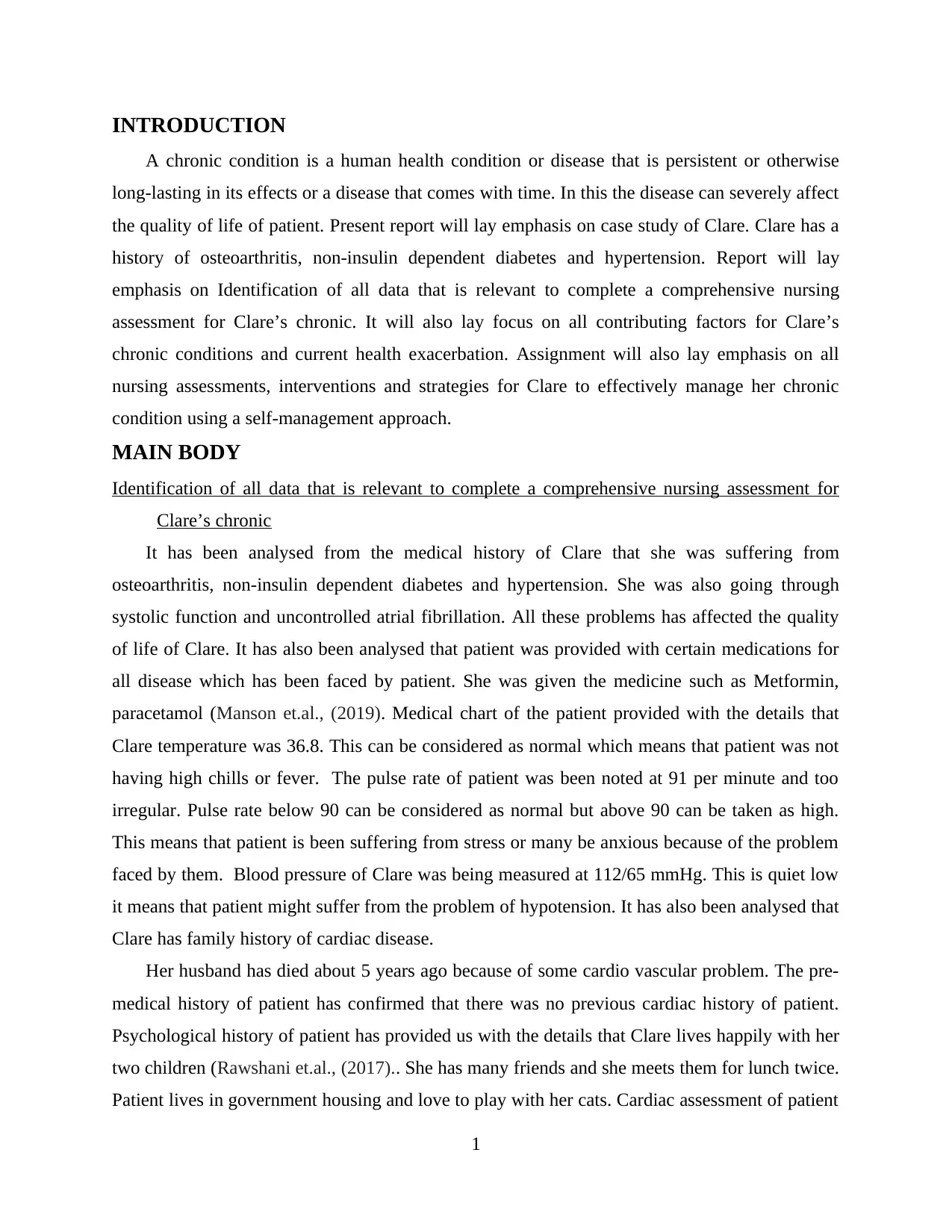
INTRODUCTION
A chronic condition is a human health condition or disease that is persistent or otherwise
long-lasting in its effects or a disease that comes with time. In this the disease can severely affect
the quality of life of patient. Present report will lay emphasis on case study of Clare. Clare has a
history of osteoarthritis, non-insulin dependent diabetes and hypertension. Report will lay
emphasis on Identification of all data that is relevant to complete a comprehensive nursing
assessment for Clare’s chronic. It will also lay focus on all contributing factors for Clare’s
chronic conditions and current health exacerbation. Assignment will also lay emphasis on all
nursing assessments, interventions and strategies for Clare to effectively manage her chronic
condition using a self-management approach.
MAIN BODY
Identification of all data that is relevant to complete a comprehensive nursing assessment for
Clare’s chronic
It has been analysed from the medical history of Clare that she was suffering from
osteoarthritis, non-insulin dependent diabetes and hypertension. She was also going through
systolic function and uncontrolled atrial fibrillation. All these problems has affected the quality
of life of Clare. It has also been analysed that patient was provided with certain medications for
all disease which has been faced by patient. She was given the medicine such as Metformin,
paracetamol (Manson et.al., (2019). Medical chart of the patient provided with the details that
Clare temperature was 36.8. This can be considered as normal which means that patient was not
having high chills or fever. The pulse rate of patient was been noted at 91 per minute and too
irregular. Pulse rate below 90 can be considered as normal but above 90 can be taken as high.
This means that patient is been suffering from stress or many be anxious because of the problem
faced by them. Blood pressure of Clare was being measured at 112/65 mmHg. This is quiet low
it means that patient might suffer from the problem of hypotension. It has also been analysed that
Clare has family history of cardiac disease.
Her husband has died about 5 years ago because of some cardio vascular problem. The pre-
medical history of patient has confirmed that there was no previous cardiac history of patient.
Psychological history of patient has provided us with the details that Clare lives happily with her
two children (Rawshani et.al., (2017).. She has many friends and she meets them for lunch twice.
Patient lives in government housing and love to play with her cats. Cardiac assessment of patient
1
A chronic condition is a human health condition or disease that is persistent or otherwise
long-lasting in its effects or a disease that comes with time. In this the disease can severely affect
the quality of life of patient. Present report will lay emphasis on case study of Clare. Clare has a
history of osteoarthritis, non-insulin dependent diabetes and hypertension. Report will lay
emphasis on Identification of all data that is relevant to complete a comprehensive nursing
assessment for Clare’s chronic. It will also lay focus on all contributing factors for Clare’s
chronic conditions and current health exacerbation. Assignment will also lay emphasis on all
nursing assessments, interventions and strategies for Clare to effectively manage her chronic
condition using a self-management approach.
MAIN BODY
Identification of all data that is relevant to complete a comprehensive nursing assessment for
Clare’s chronic
It has been analysed from the medical history of Clare that she was suffering from
osteoarthritis, non-insulin dependent diabetes and hypertension. She was also going through
systolic function and uncontrolled atrial fibrillation. All these problems has affected the quality
of life of Clare. It has also been analysed that patient was provided with certain medications for
all disease which has been faced by patient. She was given the medicine such as Metformin,
paracetamol (Manson et.al., (2019). Medical chart of the patient provided with the details that
Clare temperature was 36.8. This can be considered as normal which means that patient was not
having high chills or fever. The pulse rate of patient was been noted at 91 per minute and too
irregular. Pulse rate below 90 can be considered as normal but above 90 can be taken as high.
This means that patient is been suffering from stress or many be anxious because of the problem
faced by them. Blood pressure of Clare was being measured at 112/65 mmHg. This is quiet low
it means that patient might suffer from the problem of hypotension. It has also been analysed that
Clare has family history of cardiac disease.
Her husband has died about 5 years ago because of some cardio vascular problem. The pre-
medical history of patient has confirmed that there was no previous cardiac history of patient.
Psychological history of patient has provided us with the details that Clare lives happily with her
two children (Rawshani et.al., (2017).. She has many friends and she meets them for lunch twice.
Patient lives in government housing and love to play with her cats. Cardiac assessment of patient
1
⊘ This is a preview!⊘
Do you want full access?
Subscribe today to unlock all pages.

Trusted by 1+ million students worldwide
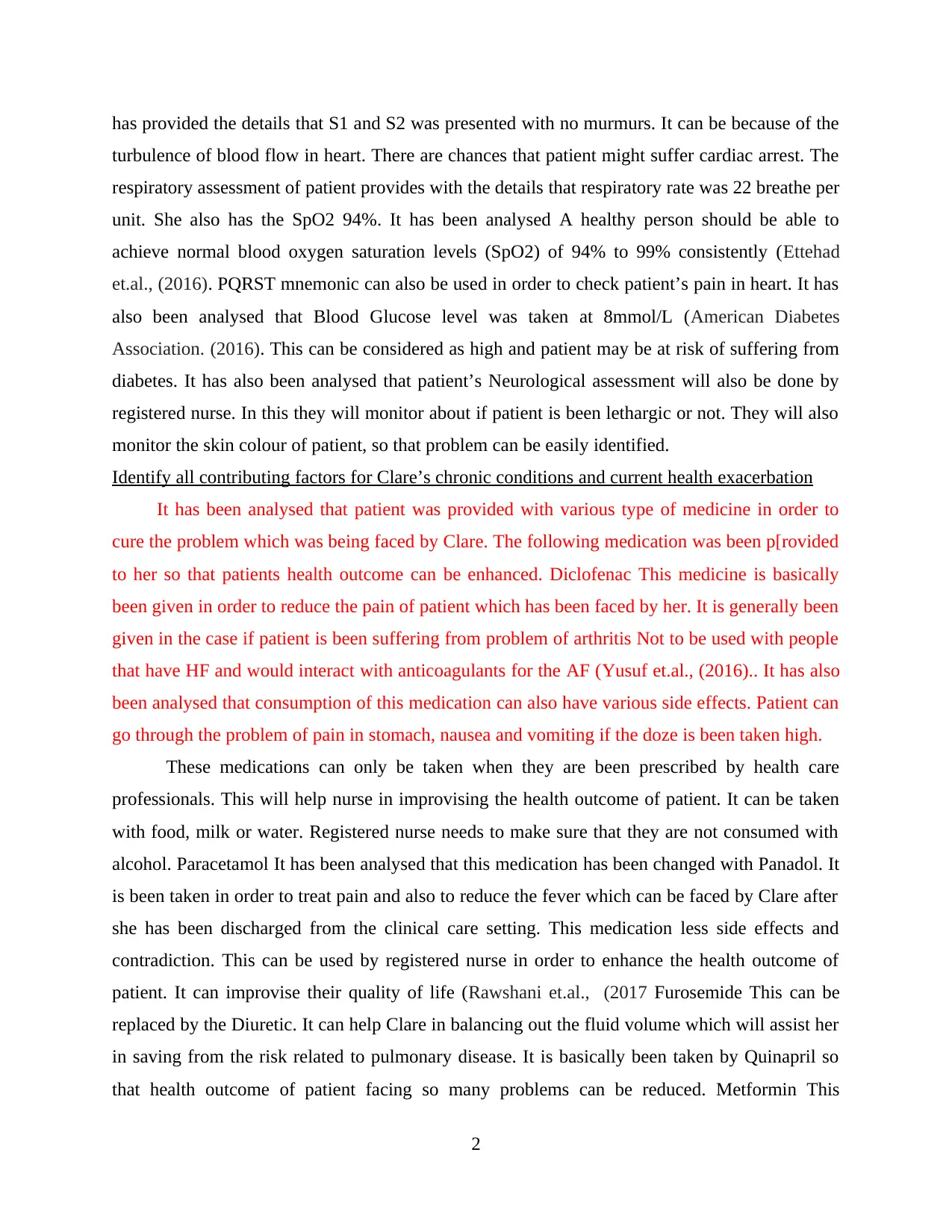
has provided the details that S1 and S2 was presented with no murmurs. It can be because of the
turbulence of blood flow in heart. There are chances that patient might suffer cardiac arrest. The
respiratory assessment of patient provides with the details that respiratory rate was 22 breathe per
unit. She also has the SpO2 94%. It has been analysed A healthy person should be able to
achieve normal blood oxygen saturation levels (SpO2) of 94% to 99% consistently (Ettehad
et.al., (2016). PQRST mnemonic can also be used in order to check patient’s pain in heart. It has
also been analysed that Blood Glucose level was taken at 8mmol/L (American Diabetes
Association. (2016). This can be considered as high and patient may be at risk of suffering from
diabetes. It has also been analysed that patient’s Neurological assessment will also be done by
registered nurse. In this they will monitor about if patient is been lethargic or not. They will also
monitor the skin colour of patient, so that problem can be easily identified.
Identify all contributing factors for Clare’s chronic conditions and current health exacerbation
It has been analysed that patient was provided with various type of medicine in order to
cure the problem which was being faced by Clare. The following medication was been p[rovided
to her so that patients health outcome can be enhanced. Diclofenac This medicine is basically
been given in order to reduce the pain of patient which has been faced by her. It is generally been
given in the case if patient is been suffering from problem of arthritis Not to be used with people
that have HF and would interact with anticoagulants for the AF (Yusuf et.al., (2016).. It has also
been analysed that consumption of this medication can also have various side effects. Patient can
go through the problem of pain in stomach, nausea and vomiting if the doze is been taken high.
These medications can only be taken when they are been prescribed by health care
professionals. This will help nurse in improvising the health outcome of patient. It can be taken
with food, milk or water. Registered nurse needs to make sure that they are not consumed with
alcohol. Paracetamol It has been analysed that this medication has been changed with Panadol. It
is been taken in order to treat pain and also to reduce the fever which can be faced by Clare after
she has been discharged from the clinical care setting. This medication less side effects and
contradiction. This can be used by registered nurse in order to enhance the health outcome of
patient. It can improvise their quality of life (Rawshani et.al., (2017 Furosemide This can be
replaced by the Diuretic. It can help Clare in balancing out the fluid volume which will assist her
in saving from the risk related to pulmonary disease. It is basically been taken by Quinapril so
that health outcome of patient facing so many problems can be reduced. Metformin This
2
turbulence of blood flow in heart. There are chances that patient might suffer cardiac arrest. The
respiratory assessment of patient provides with the details that respiratory rate was 22 breathe per
unit. She also has the SpO2 94%. It has been analysed A healthy person should be able to
achieve normal blood oxygen saturation levels (SpO2) of 94% to 99% consistently (Ettehad
et.al., (2016). PQRST mnemonic can also be used in order to check patient’s pain in heart. It has
also been analysed that Blood Glucose level was taken at 8mmol/L (American Diabetes
Association. (2016). This can be considered as high and patient may be at risk of suffering from
diabetes. It has also been analysed that patient’s Neurological assessment will also be done by
registered nurse. In this they will monitor about if patient is been lethargic or not. They will also
monitor the skin colour of patient, so that problem can be easily identified.
Identify all contributing factors for Clare’s chronic conditions and current health exacerbation
It has been analysed that patient was provided with various type of medicine in order to
cure the problem which was being faced by Clare. The following medication was been p[rovided
to her so that patients health outcome can be enhanced. Diclofenac This medicine is basically
been given in order to reduce the pain of patient which has been faced by her. It is generally been
given in the case if patient is been suffering from problem of arthritis Not to be used with people
that have HF and would interact with anticoagulants for the AF (Yusuf et.al., (2016).. It has also
been analysed that consumption of this medication can also have various side effects. Patient can
go through the problem of pain in stomach, nausea and vomiting if the doze is been taken high.
These medications can only be taken when they are been prescribed by health care
professionals. This will help nurse in improvising the health outcome of patient. It can be taken
with food, milk or water. Registered nurse needs to make sure that they are not consumed with
alcohol. Paracetamol It has been analysed that this medication has been changed with Panadol. It
is been taken in order to treat pain and also to reduce the fever which can be faced by Clare after
she has been discharged from the clinical care setting. This medication less side effects and
contradiction. This can be used by registered nurse in order to enhance the health outcome of
patient. It can improvise their quality of life (Rawshani et.al., (2017 Furosemide This can be
replaced by the Diuretic. It can help Clare in balancing out the fluid volume which will assist her
in saving from the risk related to pulmonary disease. It is basically been taken by Quinapril so
that health outcome of patient facing so many problems can be reduced. Metformin This
2
Paraphrase This Document
Need a fresh take? Get an instant paraphrase of this document with our AI Paraphraser
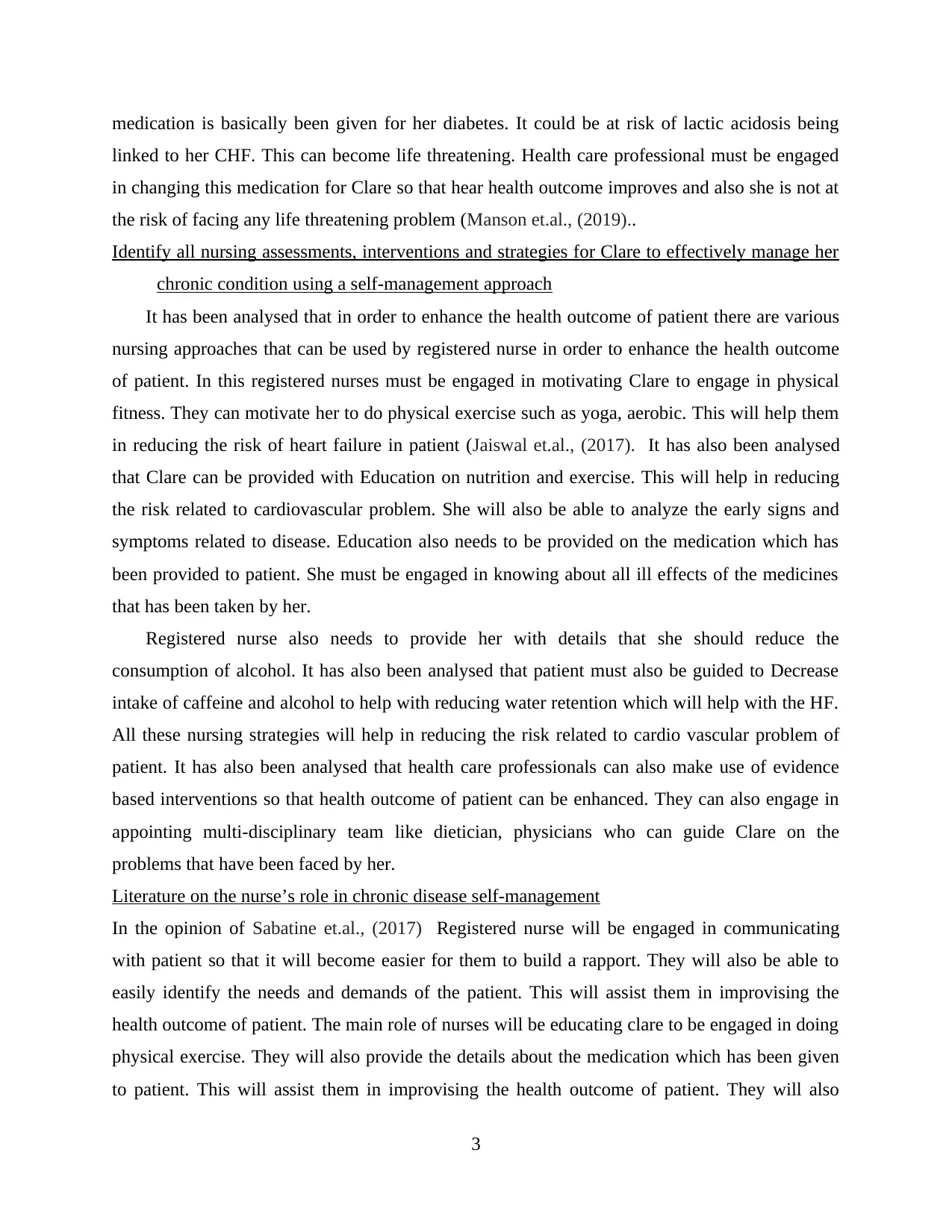
medication is basically been given for her diabetes. It could be at risk of lactic acidosis being
linked to her CHF. This can become life threatening. Health care professional must be engaged
in changing this medication for Clare so that hear health outcome improves and also she is not at
the risk of facing any life threatening problem (Manson et.al., (2019)..
Identify all nursing assessments, interventions and strategies for Clare to effectively manage her
chronic condition using a self-management approach
It has been analysed that in order to enhance the health outcome of patient there are various
nursing approaches that can be used by registered nurse in order to enhance the health outcome
of patient. In this registered nurses must be engaged in motivating Clare to engage in physical
fitness. They can motivate her to do physical exercise such as yoga, aerobic. This will help them
in reducing the risk of heart failure in patient (Jaiswal et.al., (2017). It has also been analysed
that Clare can be provided with Education on nutrition and exercise. This will help in reducing
the risk related to cardiovascular problem. She will also be able to analyze the early signs and
symptoms related to disease. Education also needs to be provided on the medication which has
been provided to patient. She must be engaged in knowing about all ill effects of the medicines
that has been taken by her.
Registered nurse also needs to provide her with details that she should reduce the
consumption of alcohol. It has also been analysed that patient must also be guided to Decrease
intake of caffeine and alcohol to help with reducing water retention which will help with the HF.
All these nursing strategies will help in reducing the risk related to cardio vascular problem of
patient. It has also been analysed that health care professionals can also make use of evidence
based interventions so that health outcome of patient can be enhanced. They can also engage in
appointing multi-disciplinary team like dietician, physicians who can guide Clare on the
problems that have been faced by her.
Literature on the nurse’s role in chronic disease self-management
In the opinion of Sabatine et.al., (2017) Registered nurse will be engaged in communicating
with patient so that it will become easier for them to build a rapport. They will also be able to
easily identify the needs and demands of the patient. This will assist them in improvising the
health outcome of patient. The main role of nurses will be educating clare to be engaged in doing
physical exercise. They will also provide the details about the medication which has been given
to patient. This will assist them in improvising the health outcome of patient. They will also
3
linked to her CHF. This can become life threatening. Health care professional must be engaged
in changing this medication for Clare so that hear health outcome improves and also she is not at
the risk of facing any life threatening problem (Manson et.al., (2019)..
Identify all nursing assessments, interventions and strategies for Clare to effectively manage her
chronic condition using a self-management approach
It has been analysed that in order to enhance the health outcome of patient there are various
nursing approaches that can be used by registered nurse in order to enhance the health outcome
of patient. In this registered nurses must be engaged in motivating Clare to engage in physical
fitness. They can motivate her to do physical exercise such as yoga, aerobic. This will help them
in reducing the risk of heart failure in patient (Jaiswal et.al., (2017). It has also been analysed
that Clare can be provided with Education on nutrition and exercise. This will help in reducing
the risk related to cardiovascular problem. She will also be able to analyze the early signs and
symptoms related to disease. Education also needs to be provided on the medication which has
been provided to patient. She must be engaged in knowing about all ill effects of the medicines
that has been taken by her.
Registered nurse also needs to provide her with details that she should reduce the
consumption of alcohol. It has also been analysed that patient must also be guided to Decrease
intake of caffeine and alcohol to help with reducing water retention which will help with the HF.
All these nursing strategies will help in reducing the risk related to cardio vascular problem of
patient. It has also been analysed that health care professionals can also make use of evidence
based interventions so that health outcome of patient can be enhanced. They can also engage in
appointing multi-disciplinary team like dietician, physicians who can guide Clare on the
problems that have been faced by her.
Literature on the nurse’s role in chronic disease self-management
In the opinion of Sabatine et.al., (2017) Registered nurse will be engaged in communicating
with patient so that it will become easier for them to build a rapport. They will also be able to
easily identify the needs and demands of the patient. This will assist them in improvising the
health outcome of patient. The main role of nurses will be educating clare to be engaged in doing
physical exercise. They will also provide the details about the medication which has been given
to patient. This will assist them in improvising the health outcome of patient. They will also
3
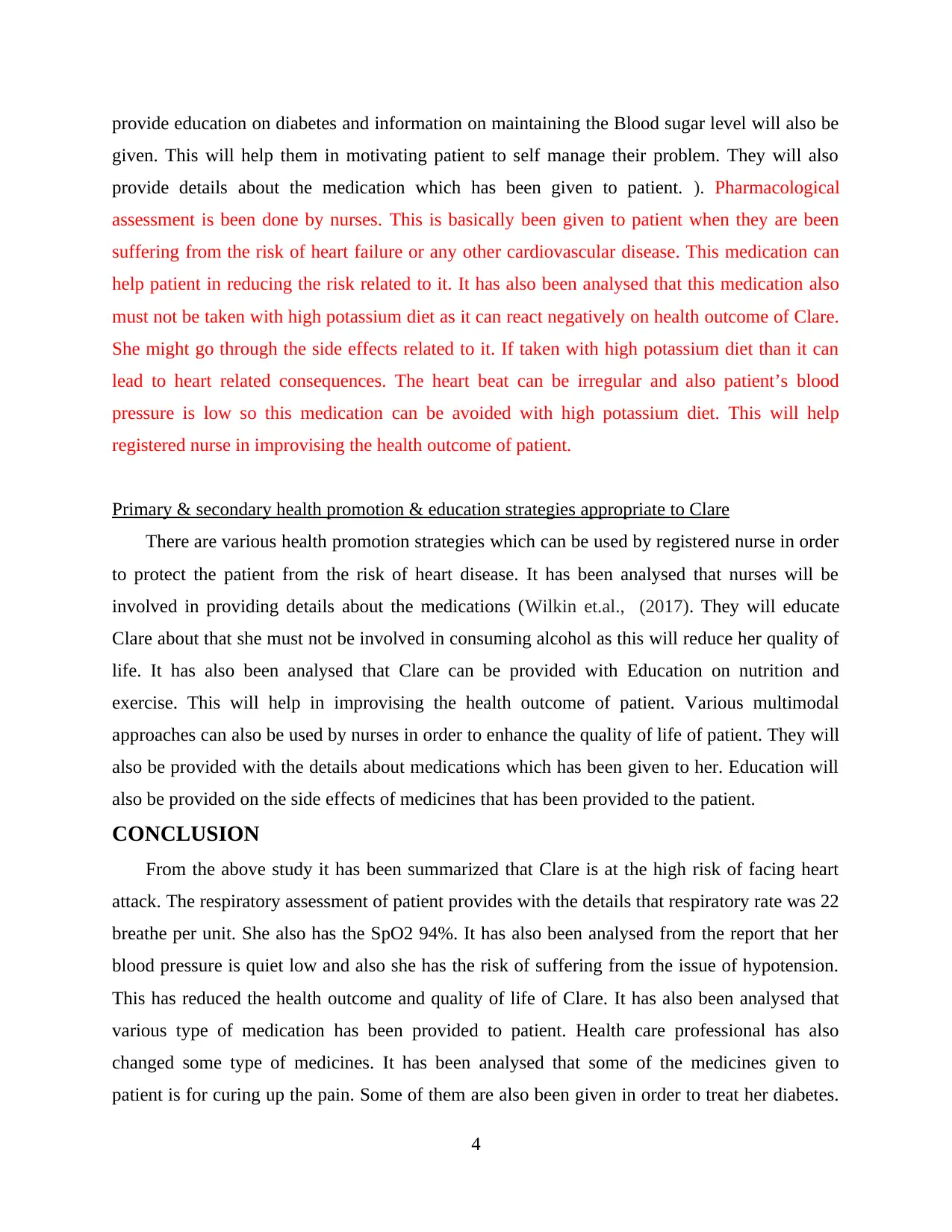
provide education on diabetes and information on maintaining the Blood sugar level will also be
given. This will help them in motivating patient to self manage their problem. They will also
provide details about the medication which has been given to patient. ). Pharmacological
assessment is been done by nurses. This is basically been given to patient when they are been
suffering from the risk of heart failure or any other cardiovascular disease. This medication can
help patient in reducing the risk related to it. It has also been analysed that this medication also
must not be taken with high potassium diet as it can react negatively on health outcome of Clare.
She might go through the side effects related to it. If taken with high potassium diet than it can
lead to heart related consequences. The heart beat can be irregular and also patient’s blood
pressure is low so this medication can be avoided with high potassium diet. This will help
registered nurse in improvising the health outcome of patient.
Primary & secondary health promotion & education strategies appropriate to Clare
There are various health promotion strategies which can be used by registered nurse in order
to protect the patient from the risk of heart disease. It has been analysed that nurses will be
involved in providing details about the medications (Wilkin et.al., (2017). They will educate
Clare about that she must not be involved in consuming alcohol as this will reduce her quality of
life. It has also been analysed that Clare can be provided with Education on nutrition and
exercise. This will help in improvising the health outcome of patient. Various multimodal
approaches can also be used by nurses in order to enhance the quality of life of patient. They will
also be provided with the details about medications which has been given to her. Education will
also be provided on the side effects of medicines that has been provided to the patient.
CONCLUSION
From the above study it has been summarized that Clare is at the high risk of facing heart
attack. The respiratory assessment of patient provides with the details that respiratory rate was 22
breathe per unit. She also has the SpO2 94%. It has also been analysed from the report that her
blood pressure is quiet low and also she has the risk of suffering from the issue of hypotension.
This has reduced the health outcome and quality of life of Clare. It has also been analysed that
various type of medication has been provided to patient. Health care professional has also
changed some type of medicines. It has been analysed that some of the medicines given to
patient is for curing up the pain. Some of them are also been given in order to treat her diabetes.
4
given. This will help them in motivating patient to self manage their problem. They will also
provide details about the medication which has been given to patient. ). Pharmacological
assessment is been done by nurses. This is basically been given to patient when they are been
suffering from the risk of heart failure or any other cardiovascular disease. This medication can
help patient in reducing the risk related to it. It has also been analysed that this medication also
must not be taken with high potassium diet as it can react negatively on health outcome of Clare.
She might go through the side effects related to it. If taken with high potassium diet than it can
lead to heart related consequences. The heart beat can be irregular and also patient’s blood
pressure is low so this medication can be avoided with high potassium diet. This will help
registered nurse in improvising the health outcome of patient.
Primary & secondary health promotion & education strategies appropriate to Clare
There are various health promotion strategies which can be used by registered nurse in order
to protect the patient from the risk of heart disease. It has been analysed that nurses will be
involved in providing details about the medications (Wilkin et.al., (2017). They will educate
Clare about that she must not be involved in consuming alcohol as this will reduce her quality of
life. It has also been analysed that Clare can be provided with Education on nutrition and
exercise. This will help in improvising the health outcome of patient. Various multimodal
approaches can also be used by nurses in order to enhance the quality of life of patient. They will
also be provided with the details about medications which has been given to her. Education will
also be provided on the side effects of medicines that has been provided to the patient.
CONCLUSION
From the above study it has been summarized that Clare is at the high risk of facing heart
attack. The respiratory assessment of patient provides with the details that respiratory rate was 22
breathe per unit. She also has the SpO2 94%. It has also been analysed from the report that her
blood pressure is quiet low and also she has the risk of suffering from the issue of hypotension.
This has reduced the health outcome and quality of life of Clare. It has also been analysed that
various type of medication has been provided to patient. Health care professional has also
changed some type of medicines. It has been analysed that some of the medicines given to
patient is for curing up the pain. Some of them are also been given in order to treat her diabetes.
4
⊘ This is a preview!⊘
Do you want full access?
Subscribe today to unlock all pages.

Trusted by 1+ million students worldwide

It has also been analysed that patients husband has died because of the cardio vascular problem.
She was living happily in the government housing. It has also been analysed that medication
given to Clare also have certain side effects. Patient can go through the problem of pain in
stomach, nausea and vomiting if the doze is been taken high. This must be taken under
supervision of health care professional.
5
She was living happily in the government housing. It has also been analysed that medication
given to Clare also have certain side effects. Patient can go through the problem of pain in
stomach, nausea and vomiting if the doze is been taken high. This must be taken under
supervision of health care professional.
5
Paraphrase This Document
Need a fresh take? Get an instant paraphrase of this document with our AI Paraphraser
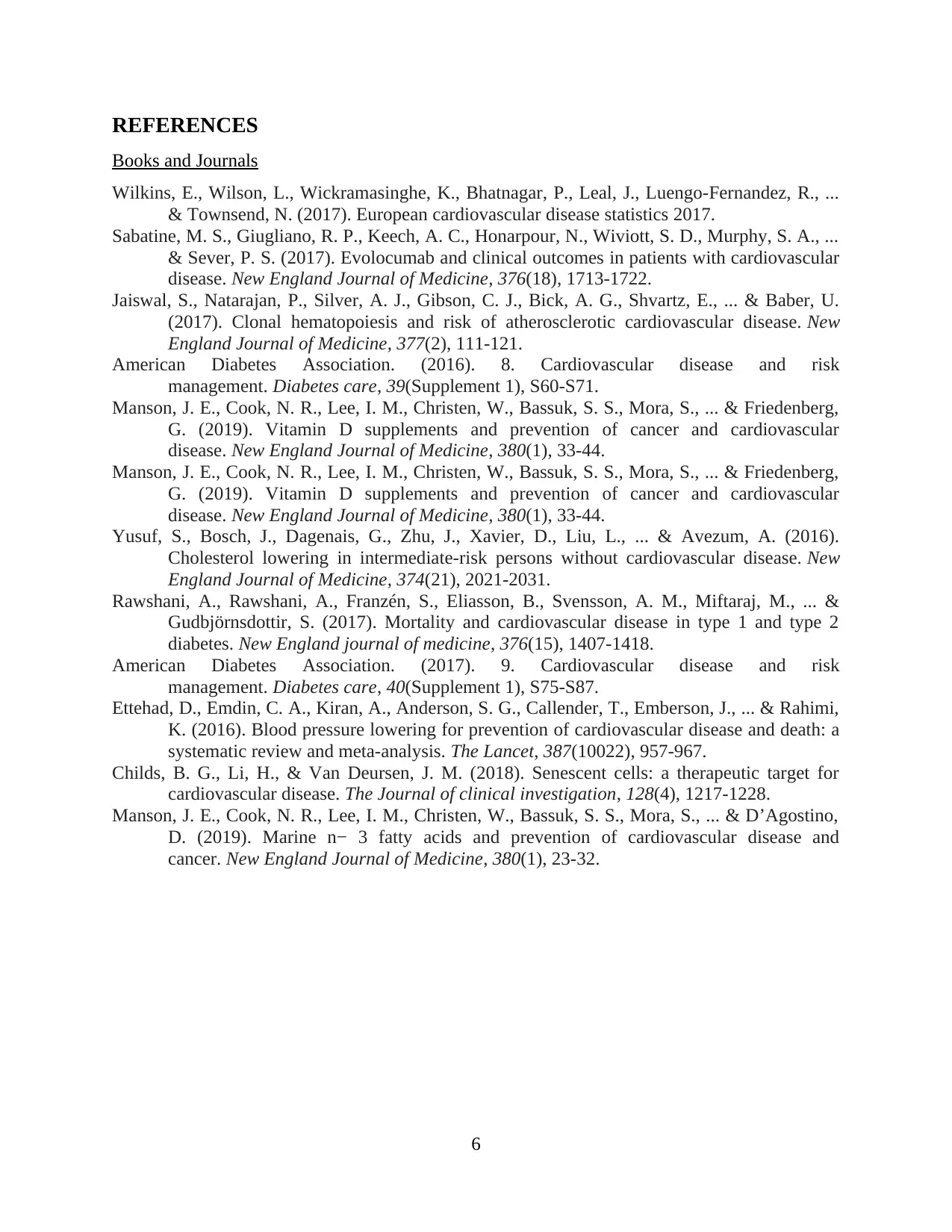
REFERENCES
Books and Journals
Wilkins, E., Wilson, L., Wickramasinghe, K., Bhatnagar, P., Leal, J., Luengo-Fernandez, R., ...
& Townsend, N. (2017). European cardiovascular disease statistics 2017.
Sabatine, M. S., Giugliano, R. P., Keech, A. C., Honarpour, N., Wiviott, S. D., Murphy, S. A., ...
& Sever, P. S. (2017). Evolocumab and clinical outcomes in patients with cardiovascular
disease. New England Journal of Medicine, 376(18), 1713-1722.
Jaiswal, S., Natarajan, P., Silver, A. J., Gibson, C. J., Bick, A. G., Shvartz, E., ... & Baber, U.
(2017). Clonal hematopoiesis and risk of atherosclerotic cardiovascular disease. New
England Journal of Medicine, 377(2), 111-121.
American Diabetes Association. (2016). 8. Cardiovascular disease and risk
management. Diabetes care, 39(Supplement 1), S60-S71.
Manson, J. E., Cook, N. R., Lee, I. M., Christen, W., Bassuk, S. S., Mora, S., ... & Friedenberg,
G. (2019). Vitamin D supplements and prevention of cancer and cardiovascular
disease. New England Journal of Medicine, 380(1), 33-44.
Manson, J. E., Cook, N. R., Lee, I. M., Christen, W., Bassuk, S. S., Mora, S., ... & Friedenberg,
G. (2019). Vitamin D supplements and prevention of cancer and cardiovascular
disease. New England Journal of Medicine, 380(1), 33-44.
Yusuf, S., Bosch, J., Dagenais, G., Zhu, J., Xavier, D., Liu, L., ... & Avezum, A. (2016).
Cholesterol lowering in intermediate-risk persons without cardiovascular disease. New
England Journal of Medicine, 374(21), 2021-2031.
Rawshani, A., Rawshani, A., Franzén, S., Eliasson, B., Svensson, A. M., Miftaraj, M., ... &
Gudbjörnsdottir, S. (2017). Mortality and cardiovascular disease in type 1 and type 2
diabetes. New England journal of medicine, 376(15), 1407-1418.
American Diabetes Association. (2017). 9. Cardiovascular disease and risk
management. Diabetes care, 40(Supplement 1), S75-S87.
Ettehad, D., Emdin, C. A., Kiran, A., Anderson, S. G., Callender, T., Emberson, J., ... & Rahimi,
K. (2016). Blood pressure lowering for prevention of cardiovascular disease and death: a
systematic review and meta-analysis. The Lancet, 387(10022), 957-967.
Childs, B. G., Li, H., & Van Deursen, J. M. (2018). Senescent cells: a therapeutic target for
cardiovascular disease. The Journal of clinical investigation, 128(4), 1217-1228.
Manson, J. E., Cook, N. R., Lee, I. M., Christen, W., Bassuk, S. S., Mora, S., ... & D’Agostino,
D. (2019). Marine n− 3 fatty acids and prevention of cardiovascular disease and
cancer. New England Journal of Medicine, 380(1), 23-32.
6
Books and Journals
Wilkins, E., Wilson, L., Wickramasinghe, K., Bhatnagar, P., Leal, J., Luengo-Fernandez, R., ...
& Townsend, N. (2017). European cardiovascular disease statistics 2017.
Sabatine, M. S., Giugliano, R. P., Keech, A. C., Honarpour, N., Wiviott, S. D., Murphy, S. A., ...
& Sever, P. S. (2017). Evolocumab and clinical outcomes in patients with cardiovascular
disease. New England Journal of Medicine, 376(18), 1713-1722.
Jaiswal, S., Natarajan, P., Silver, A. J., Gibson, C. J., Bick, A. G., Shvartz, E., ... & Baber, U.
(2017). Clonal hematopoiesis and risk of atherosclerotic cardiovascular disease. New
England Journal of Medicine, 377(2), 111-121.
American Diabetes Association. (2016). 8. Cardiovascular disease and risk
management. Diabetes care, 39(Supplement 1), S60-S71.
Manson, J. E., Cook, N. R., Lee, I. M., Christen, W., Bassuk, S. S., Mora, S., ... & Friedenberg,
G. (2019). Vitamin D supplements and prevention of cancer and cardiovascular
disease. New England Journal of Medicine, 380(1), 33-44.
Manson, J. E., Cook, N. R., Lee, I. M., Christen, W., Bassuk, S. S., Mora, S., ... & Friedenberg,
G. (2019). Vitamin D supplements and prevention of cancer and cardiovascular
disease. New England Journal of Medicine, 380(1), 33-44.
Yusuf, S., Bosch, J., Dagenais, G., Zhu, J., Xavier, D., Liu, L., ... & Avezum, A. (2016).
Cholesterol lowering in intermediate-risk persons without cardiovascular disease. New
England Journal of Medicine, 374(21), 2021-2031.
Rawshani, A., Rawshani, A., Franzén, S., Eliasson, B., Svensson, A. M., Miftaraj, M., ... &
Gudbjörnsdottir, S. (2017). Mortality and cardiovascular disease in type 1 and type 2
diabetes. New England journal of medicine, 376(15), 1407-1418.
American Diabetes Association. (2017). 9. Cardiovascular disease and risk
management. Diabetes care, 40(Supplement 1), S75-S87.
Ettehad, D., Emdin, C. A., Kiran, A., Anderson, S. G., Callender, T., Emberson, J., ... & Rahimi,
K. (2016). Blood pressure lowering for prevention of cardiovascular disease and death: a
systematic review and meta-analysis. The Lancet, 387(10022), 957-967.
Childs, B. G., Li, H., & Van Deursen, J. M. (2018). Senescent cells: a therapeutic target for
cardiovascular disease. The Journal of clinical investigation, 128(4), 1217-1228.
Manson, J. E., Cook, N. R., Lee, I. M., Christen, W., Bassuk, S. S., Mora, S., ... & D’Agostino,
D. (2019). Marine n− 3 fatty acids and prevention of cardiovascular disease and
cancer. New England Journal of Medicine, 380(1), 23-32.
6

7
⊘ This is a preview!⊘
Do you want full access?
Subscribe today to unlock all pages.

Trusted by 1+ million students worldwide
1 out of 9
Related Documents
Your All-in-One AI-Powered Toolkit for Academic Success.
+13062052269
info@desklib.com
Available 24*7 on WhatsApp / Email
![[object Object]](/_next/static/media/star-bottom.7253800d.svg)
Unlock your academic potential
Copyright © 2020–2025 A2Z Services. All Rights Reserved. Developed and managed by ZUCOL.





